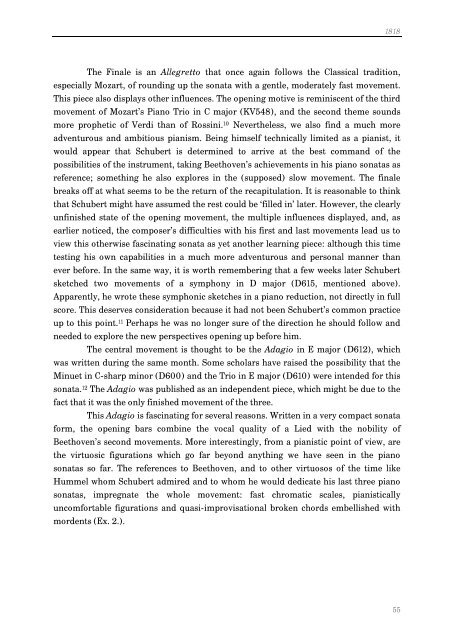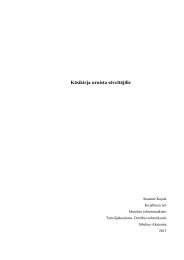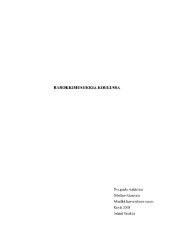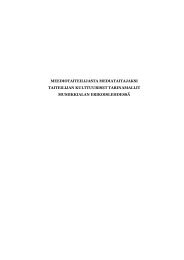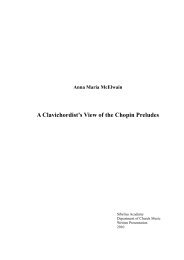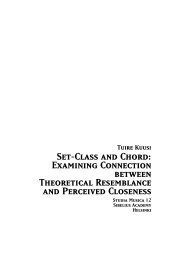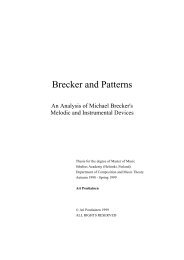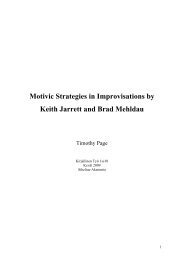The Unfinished Piano Sonatas of Franz Schubert Javier ... - Ethesis
The Unfinished Piano Sonatas of Franz Schubert Javier ... - Ethesis
The Unfinished Piano Sonatas of Franz Schubert Javier ... - Ethesis
You also want an ePaper? Increase the reach of your titles
YUMPU automatically turns print PDFs into web optimized ePapers that Google loves.
1818<br />
<strong>The</strong> Finale is an Allegretto that once again follows the Classical tradition,<br />
especially Mozart, <strong>of</strong> rounding up the sonata with a gentle, moderately fast movement.<br />
This piece also displays other influences. <strong>The</strong> opening motive is reminiscent <strong>of</strong> the third<br />
movement <strong>of</strong> Mozart’s <strong>Piano</strong> Trio in C major (KV548), and the second theme sounds<br />
more prophetic <strong>of</strong> Verdi than <strong>of</strong> Rossini. 10 Nevertheless, we also find a much more<br />
adventurous and ambitious pianism. Being himself technically limited as a pianist, it<br />
would appear that <strong>Schubert</strong> is determined to arrive at the best command <strong>of</strong> the<br />
possibilities <strong>of</strong> the instrument, taking Beethoven’s achievements in his piano sonatas as<br />
reference; something he also explores in the (supposed) slow movement. <strong>The</strong> finale<br />
breaks <strong>of</strong>f at what seems to be the return <strong>of</strong> the recapitulation. It is reasonable to think<br />
that <strong>Schubert</strong> might have assumed the rest could be ‘filled in’ later. However, the clearly<br />
unfinished state <strong>of</strong> the opening movement, the multiple influences displayed, and, as<br />
earlier noticed, the composer’s difficulties with his first and last movements lead us to<br />
view this otherwise fascinating sonata as yet another learning piece: although this time<br />
testing his own capabilities in a much more adventurous and personal manner than<br />
ever before. In the same way, it is worth remembering that a few weeks later <strong>Schubert</strong><br />
sketched two movements <strong>of</strong> a symphony in D major (D615, mentioned above).<br />
Apparently, he wrote these symphonic sketches in a piano reduction, not directly in full<br />
score. This deserves consideration because it had not been <strong>Schubert</strong>’s common practice<br />
up to this point. 11 Perhaps he was no longer sure <strong>of</strong> the direction he should follow and<br />
needed to explore the new perspectives opening up before him.<br />
<strong>The</strong> central movement is thought to be the Adagio in E major (D612), which<br />
was written during the same month. Some scholars have raised the possibility that the<br />
Minuet in C-sharp minor (D600) and the Trio in E major (D610) were intended for this<br />
sonata. 12 <strong>The</strong> Adagio was published as an independent piece, which might be due to the<br />
fact that it was the only finished movement <strong>of</strong> the three.<br />
This Adagio is fascinating for several reasons. Written in a very compact sonata<br />
form, the opening bars combine the vocal quality <strong>of</strong> a Lied with the nobility <strong>of</strong><br />
Beethoven’s second movements. More interestingly, from a pianistic point <strong>of</strong> view, are<br />
the virtuosic figurations which go far beyond anything we have seen in the piano<br />
sonatas so far. <strong>The</strong> references to Beethoven, and to other virtuosos <strong>of</strong> the time like<br />
Hummel whom <strong>Schubert</strong> admired and to whom he would dedicate his last three piano<br />
sonatas, impregnate the whole movement: fast chromatic scales, pianistically<br />
uncomfortable figurations and quasi-improvisational broken chords embellished with<br />
mordents (Ex. 2.).<br />
55


